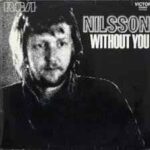 Harry Nilsson’s Without You, released in 1971, is a song that has aged like fine wine, becoming one of the quintessential heartbreak anthems of the 20th century. While Nilsson wasn’t the original composer—Pete Ham and Tom Evans of Badfinger penned the song—it was his recording that transformed it from a relatively obscure power ballad into a cultural phenomenon. Nilsson’s rendition didn’t just cover the song; it reinvented it, elevating its emotional weight and making it an indelible part of pop music history.
Harry Nilsson’s Without You, released in 1971, is a song that has aged like fine wine, becoming one of the quintessential heartbreak anthems of the 20th century. While Nilsson wasn’t the original composer—Pete Ham and Tom Evans of Badfinger penned the song—it was his recording that transformed it from a relatively obscure power ballad into a cultural phenomenon. Nilsson’s rendition didn’t just cover the song; it reinvented it, elevating its emotional weight and making it an indelible part of pop music history.
From the very first note, Without You captures a sense of yearning and loss so palpable that listeners can feel the emptiness in Nilsson’s voice. Opening with a simple yet effective piano arrangement, the track establishes a somber atmosphere that perfectly frames the vocal performance. Nilsson’s voice, capable of both gentle intimacy and soaring crescendos, navigates the song’s emotional terrain with a finesse few singers can match. There’s a vulnerability in his delivery, a sense that he is exposing raw, personal heartbreak even while performing for millions. This duality—intimate yet universal—is a hallmark of Nilsson’s genius.
Musically, Without You is deceptively simple. The song follows a traditional structure, moving from verse to chorus with a bridge that escalates the tension before returning to the heart-wrenching refrain. The arrangement, led by Richard Perry’s production, strikes a careful balance between lush orchestration and restrained instrumentation. Strings swell at just the right moments, accentuating the drama without overwhelming Nilsson’s vocals. The piano underpins the track with a melodic clarity that makes each chord feel like a pulse of the heart, mirroring the emotional content of the lyrics. Drums and subtle percussion add rhythm and momentum, but never distract from the song’s central focus: the pain of losing someone indispensable.
Nilsson’s vocal performance is nothing short of iconic. He has a remarkable ability to convey desperation without tipping into melodrama. Each note carries a weight of longing that feels genuine, and the climactic moments, particularly in the chorus, demonstrate his extraordinary range and control. The repeated refrain of “I can’t live if living is without you” is delivered with a sincerity that makes it impossible not to empathize. Nilsson’s phrasing is meticulous; he stretches certain vowels and emphasizes consonants in a way that heightens the song’s emotional resonance. This is not just a song to be heard—it’s a song to be felt.
Lyrically, Without You is a masterclass in expressing universal heartbreak with elegant simplicity. The words capture the disorientation and despair that follows the end of a relationship, yet they are broad enough to resonate with anyone who has experienced loss. Lines like “I can’t forget this evening / or your face as you were leaving” create vivid imagery while allowing listeners to project their own experiences onto the song. The universal theme of emptiness after separation is paired with Nilsson’s emotional interpretation to make the song timeless. It’s this universality, combined with his vocal prowess, that explains why Without You has been covered by countless artists across generations, from Mariah Carey to Air Supply, each attempting to capture the same magic Nilsson achieved in 1971.
The production quality of the track deserves special mention. Richard Perry, who had a longstanding collaborative relationship with Nilsson, ensures that every element of the song serves its emotional purpose. The orchestration is rich but never overwhelming, the piano lines are precise and evocative, and the subtle backing vocals add depth without overshadowing the lead. The mix gives Nilsson’s voice a forward position, ensuring that his performance remains the focal point. The recording captures the warmth and nuance of his voice beautifully, a testament to the technical skill behind the production. Even decades later, Without You sounds pristine, retaining its emotional impact and sonic clarity.
Without You also occupies an interesting place in Nilsson’s career. By 1971, he was already recognized as a gifted singer-songwriter with hits like Everybody’s Talkin’ under his belt, but this song elevated him to a new level of mainstream visibility. It became his first number-one hit on the Billboard Hot 100, cementing his reputation as a pop powerhouse capable of delivering profound emotion. Unlike some of his more whimsical or experimental work, this track showcased his ability to connect with listeners on a deeply personal level. It demonstrated that Nilsson could balance technical mastery with raw emotional expression, a duality that few artists manage to achieve consistently.
The song’s cultural impact cannot be overstated. It has appeared in films, television shows, and commercials, often serving as shorthand for heartbreak and longing. The emotional resonance of Nilsson’s performance has made it an enduring reference point in popular culture, a benchmark for the power ballad genre. Even today, decades after its release, Without You continues to inspire new generations of musicians and singers, proving that true artistry transcends time.
One of the most fascinating aspects of Without You is the way it captures the intersection of personal emotion and musical craftsmanship. Nilsson’s performance is emotionally raw yet meticulously controlled, demonstrating a rare ability to blend vulnerability with precision. The song’s structure, production, and instrumentation all serve this emotional arc, creating a cohesive experience that feels both intimate and grandiose. It’s a rare combination that contributes to the track’s timeless appeal.
Nilsson’s interpretation also exemplifies the transformative power of a great cover. While Badfinger wrote the song and recorded a version on their 1970 album No Dice, it was Nilsson who turned it into a global phenomenon. He respected the original composition while infusing it with his own vocal personality and emotional depth, demonstrating a profound understanding of how to reinterpret material without losing its essence. In doing so, he set a standard for how artists could make a song entirely their own while honoring its origins.
Even the song’s legacy within Nilsson’s catalog is significant. It stands as a testament to his vocal range, emotional sensitivity, and ability to communicate complex feelings through music. While some of his other works leaned toward humor, experimental arrangements, or offbeat lyrical content, Without You allowed Nilsson to reveal a more vulnerable and universally relatable side of his artistry. It is a track that encapsulates his duality as an artist: playful and serious, technical and emotional, intimate and grand.
Decades later, the emotional power of Without You remains undiminished. It’s a song that continues to resonate because it speaks to a fundamental human experience—the sense of incompleteness when someone essential is gone. Nilsson’s performance, combined with the careful production and timeless lyrics, ensures that it is not merely a hit of the early 1970s but a perennial classic. Its influence can be seen in the countless covers and references across music and media, demonstrating the enduring power of a well-executed emotional ballad.
Ultimately, Without You is more than just a song about heartbreak—it is a study in the art of emotional expression through music. Harry Nilsson took a beautiful composition and infused it with a depth of feeling that made it unforgettable. The track showcases his extraordinary vocal talent, the sophistication of 1970s production, and the timeless universality of love and loss. Every listen is a reminder of why Nilsson remains one of the most admired and respected voices of his generation.
Without You is, in many ways, the definitive heartbreak song of the early 1970s, a musical statement that balances vulnerability with grandeur and simplicity with sophistication. It captures a moment in time while remaining timeless, a rare feat that solidifies its place in music history. Harry Nilsson’s 1971 rendition didn’t just interpret a song—it immortalized it, leaving listeners with a piece of art that continues to resonate across decades and generations.


